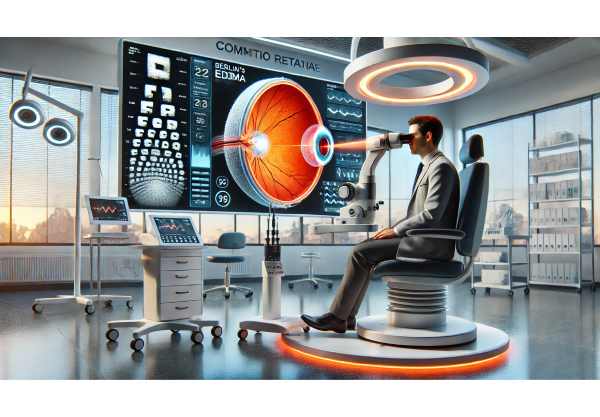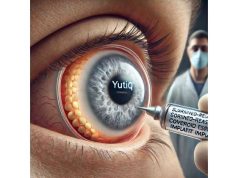
Commotio retinae, also known as Berlin’s edema, is a traumatic injury to the retina often resulting from blunt force impact to the eye. Characterized by a transient whitening of the retina and vision changes, this condition is a clinical hallmark of ocular trauma. While commotio retinae frequently resolves without intervention, it can lead to persistent visual impairment in severe cases or if complications arise. This comprehensive guide covers all aspects of commotio retinae—from early recognition and evidence-based treatments to surgical interventions and the latest breakthroughs—so that patients, families, and clinicians can make informed, empowered decisions.
Table of Contents
- Condition Overview and Epidemiology
- Conventional and Pharmacological Therapies
- Surgical and Interventional Procedures
- Emerging Innovations and Advanced Technologies
- Clinical Trials and Future Directions
- Frequently Asked Questions
- Disclaimer
Condition Overview and Epidemiology
Commotio retinae, or Berlin’s edema, is a traumatic retinopathy resulting from blunt ocular injury. The condition manifests as a transient gray-white opacification of the retina, particularly in the posterior pole (macula), with associated visual disturbances. Most often seen in young adults and adolescents involved in sports, physical altercations, or accidents, commotio retinae is a visible sign of trauma-induced photoreceptor and retinal pigment epithelium (RPE) disruption.
Pathophysiology and Mechanisms:
- The force from trauma compresses the eye, causing rapid deformation and transmission of shock waves to the retina.
- The result is transient disruption of the outer retinal layers (mainly photoreceptors and RPE), leading to intracellular swelling (edema) and opacification.
- In some cases, the macula—the central vision area—is involved, potentially causing persistent central vision loss.
Epidemiology:
- Common in contact sports, road traffic accidents, falls, and assaults.
- Most cases occur in healthy, active individuals between 10–40 years old.
- Males are more frequently affected due to higher risk activity participation.
Clinical Features:
- Sudden onset of blurred vision, visual field defects, or decreased visual acuity after trauma
- A well-demarcated, gray-white area of retinal opacity seen on dilated fundus examination
- If the macula is involved, patients may experience central vision loss or metamorphopsia (distorted vision)
- Typically painless; associated with other signs of ocular trauma, such as subconjunctival hemorrhage or hyphema
Risk Factors:
- Participation in high-impact sports without eye protection
- Occupational or recreational activities with risk of blunt eye injury
- Previous ocular trauma or history of eye surgery
Diagnosis:
- Clinical exam with indirect ophthalmoscopy or slit-lamp biomicroscopy
- Optical coherence tomography (OCT) reveals disruption of the photoreceptor layer and mild retinal thickening
- Ancillary imaging (fundus photography, fluorescein angiography) may be used to rule out concurrent injuries
Practical Advice:
If you experience sudden vision changes after an eye injury—even if discomfort is minimal—seek urgent evaluation by an eye specialist. Early diagnosis can help identify complications and support optimal recovery.
Conventional and Pharmacological Therapies
For most cases of commotio retinae, the cornerstone of management is conservative care, emphasizing careful monitoring and supportive measures to protect vision and prevent complications.
Observation and Monitoring:
- The vast majority of cases resolve spontaneously over days to weeks.
- Regular follow-up exams assess visual acuity, monitor for complications (such as retinal detachment or choroidal rupture), and ensure gradual recovery.
- Repeat imaging (OCT, fundus photography) documents healing and tracks resolution of retinal edema.
Supportive Therapies:
- Rest and Eye Protection:
- Limiting strenuous activity and protecting the eye from further injury can aid in healing.
- Avoidance of contact sports or hazardous environments until the retina has fully healed.
- Artificial Tears and Lubricants:
- Help relieve ocular surface irritation, especially if associated corneal abrasions are present.
- Pain Management:
- Nonsteroidal anti-inflammatory drugs (NSAIDs) or acetaminophen for discomfort from associated injuries.
Pharmacological Approaches:
- Topical or Systemic Corticosteroids:
- Sometimes prescribed in cases with severe inflammation or suspected immune-mediated response.
- The evidence for benefit is limited, so routine use is not recommended.
- Anti-Edema Agents:
- No established pharmacologic agents specifically reverse commotio retinae; most drugs are used to address complications or comorbidities.
Complication Monitoring:
- Early detection of retinal tears, detachment, or choroidal rupture is crucial.
- Education on warning symptoms—new flashes, floaters, curtain-like vision loss—is essential.
Practical Advice:
Attend all scheduled follow-ups, even if your vision seems to improve. Protect your eye from further trauma and report any sudden visual changes immediately.
Surgical and Interventional Procedures
While commotio retinae itself seldom requires surgery, it often occurs alongside injuries that may demand operative management. Recognizing and addressing these complications promptly is vital for preserving vision.
Surgical Interventions for Associated Injuries:
- Retinal Detachment Repair:
- Retinal tears or detachment may occur with severe trauma.
- Treatment options include pneumatic retinopexy (gas bubble), scleral buckling, or pars plana vitrectomy depending on the extent and location.
- Choroidal Rupture Management:
- Observation is usually indicated; however, secondary complications such as choroidal neovascularization may require anti-VEGF injections or laser therapy.
- Vitreous Hemorrhage:
- Persistent or visually significant hemorrhage may necessitate vitrectomy.
- Hyphema or Traumatic Cataract:
- May require anterior segment surgery for vision restoration or to prevent secondary glaucoma.
Adjunctive Minimally Invasive Procedures:
- Laser Photocoagulation:
- Used to surround retinal breaks or high-risk areas in select cases to prevent retinal detachment.
Recovery and Rehabilitation:
- Post-surgical care includes rest, use of prescribed medications, and gradual return to activity.
- Visual rehabilitation with low vision aids may be necessary in cases of persistent impairment.
Practical Advice:
Ask your retinal surgeon to explain all risks and benefits of proposed procedures. Understand the timeline for expected recovery and the warning signs of potential complications.
Emerging Innovations and Advanced Technologies
Ongoing research and technological advances are improving both diagnosis and outcomes in commotio retinae and related traumatic retinal injuries.
Diagnostic Innovations:
- High-Resolution OCT:
- Advances in spectral domain and swept-source OCT now allow visualization of subtle photoreceptor disruption and tracking of recovery over time.
- Ultra-Widefield Imaging:
- Captures peripheral lesions and associated injuries in a single image, aiding comprehensive assessment.
Therapeutic Breakthroughs:
- Neuroprotective Agents:
- Experimental drugs aim to protect or restore photoreceptor integrity after trauma; clinical use is pending ongoing trials.
- Regenerative Medicine:
- Early-stage research explores stem cell therapies and gene editing for restoring function in severely damaged retinas.
Digital Rehabilitation Tools:
- Vision Training Apps:
- Interactive programs designed to optimize neuroadaptation and visual performance after injury.
- Telemedicine:
- Virtual follow-up platforms ensure continuous monitoring and early detection of delayed complications.
Artificial Intelligence Applications:
- AI-driven image analysis for early detection of subtle retinal changes and automated tracking of healing.
Practical Advice:
If you have persistent visual loss or are interested in innovative therapies, ask about research opportunities or referrals to tertiary eye care centers specializing in traumatic retinal disease.
Clinical Trials and Future Directions
The future of commotio retinae management is being shaped by a robust pipeline of research in neuroprotection, regeneration, and digital health.
Areas of Active and Upcoming Research:
- Neuroprotective Therapies:
- Ongoing studies evaluating drugs that reduce cell death or promote regeneration in traumatized retinas.
- Gene and Cell-Based Approaches:
- Preclinical work in animal models; translation to human clinical trials anticipated in coming years.
- Advanced Imaging Research:
- AI-assisted imaging for better stratification of injury severity and prediction of outcomes.
- Outcome Registries and Big Data:
- Large-scale patient registries collecting data on trauma, treatment, and recovery to inform best practices.
- Digital Rehabilitation:
- Trials of vision therapy apps, telemedicine follow-up, and patient-reported outcomes.
Patient Participation and Access:
- Some clinical trials are enrolling at leading ophthalmology and trauma centers.
- Research participation offers close monitoring, access to new therapies, and the chance to contribute to improved care for future patients.
Looking Ahead:
- Personalized medicine, incorporating genetic, imaging, and clinical data, is likely to transform how commotio retinae and related injuries are managed.
- Patient-centered outcomes and digital monitoring will play an increasing role in long-term follow-up and rehabilitation.
Practical Advice:
Consider joining patient registries or clinical trials if you meet eligibility criteria. Your participation can help accelerate discoveries and support better care for everyone with ocular trauma.
Frequently Asked Questions
What is commotio retinae (Berlin’s edema) and how does it occur?
Commotio retinae is a traumatic injury to the retina caused by blunt force, resulting in temporary whitening and vision changes. It’s often seen after sports injuries, falls, or accidents.
How long does it take for commotio retinae to heal?
Most cases resolve within two to four weeks, but some may have lingering vision loss if the macula or other vital structures are severely affected.
Can commotio retinae lead to permanent vision loss?
Yes, especially if the central retina (macula) is involved or if there are complications like retinal detachment. Prompt evaluation and monitoring are crucial.
What treatments are available for commotio retinae?
Most cases require observation and supportive care. Surgical intervention is only needed if complications such as retinal tears or detachment occur.
Is it necessary to use medications for commotio retinae?
No medication directly treats commotio retinae. Supportive therapies may be used for symptoms, and steroids are rarely considered in select cases.
Can I prevent commotio retinae?
Wearing appropriate eye protection during sports and high-risk activities is the best prevention. Avoiding trauma reduces the risk significantly.
Are there new treatments or clinical trials for commotio retinae?
Ongoing research includes neuroprotective drugs, regenerative therapies, and advanced imaging. Ask your ophthalmologist about available clinical trials at specialized centers.
Disclaimer
The information in this article is for educational purposes only and is not a substitute for professional medical advice, diagnosis, or treatment. Please consult an ophthalmologist or qualified healthcare provider for advice about your specific condition or symptoms.
If you found this article helpful, please share it on Facebook, X (formerly Twitter), or your favorite platform. Your support helps us provide accessible, quality health content to more people. Don’t forget to follow us for the latest updates and eye health resources!










